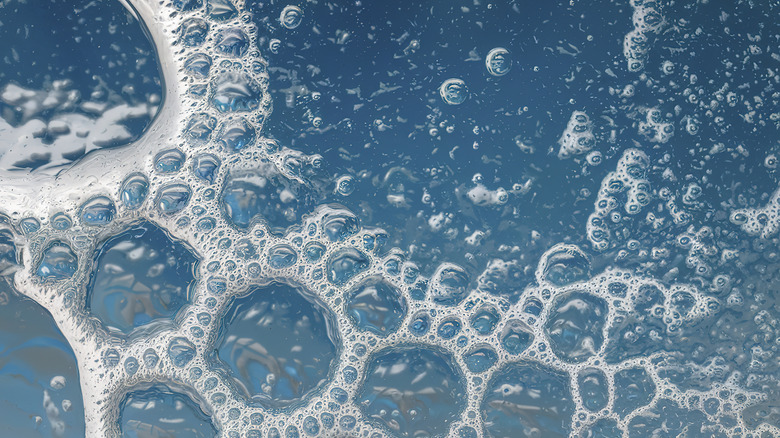The Trick To Removing Aphids Off Your Plant Is Simply Soapy Water
Of the 5000 species of aphids in the world, about 1350 appear in the U.S. They average about 1/8 inch long and can be a number of colors, including green, brown, red, white, and even multicolored. While not all aphid species are pests, almost all plants attract at least one aphid species. Fortunately, aphids are easy to control without the pesticides that also harm beneficial insects you should avoid killing at all costs. They're not tenacious bugs — spraying the plants with water removes most aphids. Adding soap to the water introduces an insecticidal element. Scientists still aren't quite sure why soap is effective against some insects, but they believe that part of the answer is that soap disrupts the bugs' cell membranes.
If you see yellowed leaves, poor growth, or curled leaves on your plants, but can't see insects, check for aphids on the underside of a leaf. Small populations of these insects don't usually cause problems other than cosmetic ones, but those cosmetic issues may affect your enjoyment of your garden. Aphids rarely kill plants, but large numbers of them, left untreated, can suck enough sap from the plants to damage them. Aphids can also transmit diseases from plant to plant or excrete enough honeydew that nearby objects like lawn furniture or a parked car can become coated with the sticky waste substance. Honeydew attracts insects like flies, ants, and wasps, insects you may not want in your garden.
Using soapy water to remove aphids
It's easier to control the aphid population when it's small, so check for aphids twice a week when your garden is growing quickly, typically in the spring. If you only find a few, it's okay to just squash them between your fingers. A large population of ants can also be an indicator, as they may be eating the honeydew produced by the aphids. Commercial insecticidal soaps are available for sale, but you may be just as successful with a DIY product. Mix one tablespoon of liquid dish soap per gallon of water, pour it into a hose end sprayer, and spray the plant, making sure to get the undersides of the leaves. Make sure the plants you're spraying can stand up to a strong stream of water and if they can't, apply the soapy water with a hand-held sprayer. Continue to check for aphids regularly and spray as needed. If you see yellow or brown spots on the leaves after you've sprayed, the plant may be sensitive to the soap. If that's the case, use other methods, like introducing aphid-eating ladybugs for natural garden pest control or growing companion plants like catnip (Nepeta) to repel the pests.
Spray the plants thoroughly in the morning or the evening, but not to the point that the water runs off. Avoid spraying when it's hot and sunny. Check how hard your water is, as it could be toxic to your plants. Consider buying distilled water to use in your spray instead. Don't use soapy water anywhere that it can get into lakes or streams as it can cause significant problems for aquatic life.

